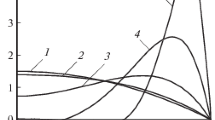Abstract
The process of laminarization of turbulent flow with heat transfer in a plane confuser with a constant constriction angle is numerically simulated. The effect of the favorable longitudinal pressure gradient on the flow and heat transfer parameters is shown. The results of the calculations are compared with the experimental data on the heat transfer. The value of the acceleration parameter, at which flow in the channel becomes fully laminar, is determined.
Similar content being viewed by others
References
J. Sternberg, “The transition from a turbulent to a laminar boundary layer,” US Army Bal. Res. Lab. Aberdeen, Rep. 906 (1954).
A. S. Ginevskii, V. A. Ioselevich, A. V. Kolesnikov, et al., “Methods of calculation of turbulent boundary layers,” in: Advances in Science and Engineering. All-Union Institute of Science and Technical Information. Fluid Mech. Series. Vol. 11 (Moscow, 1978), p. 155 [in Russian].
R. Narashima and K. R. Sreenivasan, “Relaminarization fluid flows,” Adv. Appl.Mech. 19, 221 (1979).
B. A. Kader and A. M. Yaglom, “Effect of roughness and a longitudinal pressure gradient on turbulent boundary layers,” in: Advances in Science and Engineering. All-Union Institute of Science and Technical Information. Fluid Mech. Series. Vol. 18 (Moscow, 1984), p. 3 [in Russian].
V. G. Lushchik, A. A. Pavel'ev, and A. E. Yakubenko, “Transport equations for turbulence characteristics: models and results of calculations,” in: Advances in Science and Engineering. All-Union Institute of Science and Technical Information. Fluid Mech. Series, Vol. 22 (Moscow, 1988), p. 3. [in Russian]
P. H. Moretti and V. M. Kays, “Heat transfer in turbulent boundary layer with varying freestream velocity and varying surface temperature—an experimental study,” Int. J. HeatMass Transfer 8, 1187 (1965).
K. R. Sreenivasan, “Laminariscent, relaminarizing and retransitional flows,” Acta Mech. 44, 1 (1982).
M. A. Badry Narayanan and V. Ramjee, “On the criteria for reverse transition in a two-dimensional boundarylayer flow,” J. Fluid Mech. 35 (2), 225 (1969).
A. N. Sekundov, “Application of a differential equation for turbulent viscosity to the analysis of plane nonself-similar flows,” Fluid Dynamics 6 (5), 828 (1971).
E. P. Volchkov, M. S. Makarov, and A. Yu. Sakhnov, “Boundary layer with asymptotic favourable pressure gradient,” Int. J. HeatMass Transfer 53, 2837 (2010).
C. Bourassa and F. O. Thomas, “An experimental investigation of a highly accelerated turbulent boundary layer,” J. FluidMech. 634, 359 (2009).
M. B. Jones, I. Marusic, and A. E. Perry, “Evolution and structure of sink-flow turbulent boundary layers,” J. FluidMech. 428, 1 (2001).
M. P. Escuder, A. Abdel-Hameed, M. W. Johnson, and C. J. Sutcliffe, “Laminarization and retransition of a turbulent boundary layer subjected to favourable pressure gradient,” Exp. Fluids 25, 491 (1998).
C. A. Bankston, “The transition from turbulent to laminar gas flow in a heated pipe,” J. Heat Transfer 92 (4), 569 (1970).
A. I. Leont'ev, A. N. Oblivin, and P. N. Romanenko, “Investigation of drag and heat transfer in turbulent air flows in axisymmetric channels with a longitudinal pressure gradient,” Zh. Prikl. Mekh. Tekhn. Fiz. 5, 17 (1961).
H. Tanaka and J.-I. Shimitzu, “Laminarization in low reynolds number turbulent duct flows,” J. Heat Transfer 99 (4), 682 (1977).
H. Tanaka, H. Kawamura, A. Tateno, and S. Hatamiya, “Effect of laminarization and retransition on heat transfer for low reynolds number flows through a converging to constant area duct,” J. Heat Transfer 104 (2), 363 (1982).
A. Talamelli, N. Fornaciari, K. Johan, A. Westin, and P. H. Alfredsson, “Experimental investigation of streaky structures in a relaminarizing boundary layer,” J. Turbulence 3, 018 (2002).
M. Ichimiya, I. Nakamura, and S. Yamashita, “Properties of a relaminarizing turbulent boundary layer under a favorable pressure gradient,” Exp. Thermal Fluid Sci. 17 (1–2), 37 (1998).
M. Ichimiya, Y. Nakase, I. Nakamura, S. Yamashita, J. Fukutomi, and M. Yoshikawa, “Properties of a relaminarizing turbulent boundary layer under a favorable pressure gradient (analysis of bursting structure with VITA technique),” Trans. Japan Soc.Mech. Engineers Part B 62 (594), 483 (1998).
H. Schlichting, Boundary Layer Theory (McGraw-Hill, New York, 1979).
U. R. Oriji, S. Karimisani, and P. G. Tucker, “RANS modeling of accelerating boundary layers,” J. Fluid Eng. Trans. ASME 137 (1), Paper No. A12 (2015).
V. G. Lushchik, A. A. Pavel'ev, and A. E. Yakubenko, “Three-parameter model of shear turbulence,” Fluid Dynamics 13 (3), 350 (1978).
V. G. Lushchik, A. A. Pavel'ev, and A. E. Yakubenko, “Three-parameter model of turbulence. Heat transfer calculations,” Fluid Dynamics 21 (2), 200 (1986).
V. G. Lushchik, A. A. Pavel'ev, and A. E. Yakubenko, “Transfer equation for turbulent heat flux. calculation of heat exchange in a pipe,” Fluid Dynamics 23 (6), 835 (1988).
V. G. Lushchik, V. I. Sizov, and A. E. Yakubenko, “Using the narrow channel approximation for calculating turbulent flows in the nozzles of liquid rocket engines,” Teplofiz. Vys. Temp. 31 (5), 752 (1993).
Acknowledgements
The study was carried out with the support of the Russian Foundation for Basic Research (project no. 17-08-00115) and the Council of Grants of the President of Russian Federation (no. SP-3993.2018.1).
Author information
Authors and Affiliations
Corresponding authors
Additional information
Russian Text © The Author(s), 2019, published in Izvestiya Rossiiskoi Akademii Nauk, Mekhanika Zhidkosti i Gaza, 2019, No. 1, pp. 68–77.
Rights and permissions
About this article
Cite this article
Lushchik, V.G., Makarova, M.S. & Reshmin, A.I. Laminarization of Flow with Heat Transfer in a Plane Channel with a Confuser. Fluid Dyn 54, 67–76 (2019). https://doi.org/10.1134/S0015462819010099
Received:
Revised:
Accepted:
Published:
Issue Date:
DOI: https://doi.org/10.1134/S0015462819010099



